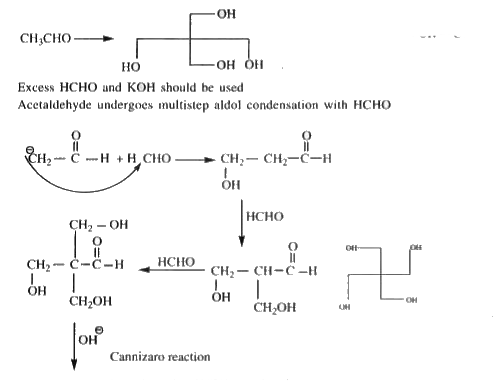Acetaldehyde can be converted in to OHCH2−CH2OH∣C∣CH2OH−CH2OH by which reagent Solution in Telugu
KOH
KOH and KAH
excess HCHO and KOH
KCN followed by SBH
The correct Answer is:C
Topper's Solved these Questions
- ALDEHYDES AND KETONESBOOK - AAKASH SERIESCHAPTER - ALDEHYDES AND KETONESEXERCISE - LEVEL-II LECTURE SHEET (EXERCISE-II)
28 Videos
- ALDEHYDES AND KETONESBOOK - AAKASH SERIESCHAPTER - ALDEHYDES AND KETONESEXERCISE - LEVEL-II LECTURE SHEET (EXERCISE-III)
11 Videos
- ALDEHYDES AND KETONESBOOK - AAKASH SERIESCHAPTER - ALDEHYDES AND KETONESEXERCISE - LEVEL-I(EXERCISE-II)
59 Videos
- ALCOHOLS, PHENOLS AND ETHERSBOOK - AAKASH SERIESCHAPTER - ALCOHOLS, PHENOLS AND ETHERSEXERCISE - ETHERS (OBJECTIVE EXERCISE-4)
50 Videos
- ALKYL AND ARYL HALIDESBOOK - AAKASH SERIESCHAPTER - ALKYL AND ARYL HALIDESEXERCISE - OBJECTIVE EXERCISE - 4 (ASSERTION (A) & REASON (R) TYPE QUESTIONS)
19 Videos
Similar Questions
Which of the following give N- subtituted amide from ketoxime ?
View SolutionAldehydes and ketons are susceptible to nuclephlic addition because carbonylgroup

Polar (due to electronegativeity difference between carbon and oxygen
positive charge on carbonyl compound towards nucleophilic . this addition is catalysed by acid . REactivity of carbonyl compound towards nuclephilic addotion increase with increase in teh electron deficiency at carbonyl carbon Thus (-I.E ) groups increase while (+I.E ) groups decreases the reactivity of carbonyl compound .
which among the following is most reactive towards nuclephilic addition
View SolutionEthylene is converted to X on passing through a mixture of an acidified aqueous solution of palladium chloride and cupric chloride. Which of the following reagents readily take part in addition reaction with X ?
View Solution(A): Alcoholic fermentation involves conversion of sugar into ethanol by the action of yeast.
(R): Fermentation involves the liberation of CO2 gas.
View Solution(A) Towards SN2 reaction, order of reactivity is CH3Br>CH3CH2Br>(CH3)2CHBr>(CH3)3CBr.
(R) Greater the stability of carbocation, greater will be its ease of formation from alkyl halide and faster will be the rate of SN1 reaction.
View SolutionIn the reactions underset(CH_2)overset(CH_2)(||)underset"acid"overset"Hypochlorous"to M oversetRtounderset(CH_2OH)overset(CH_2OH)| M and R are respectively
View SolutionR−CH2−CH2OH can be converted into RCH2CH2COOH. The correct sequence of reagent is
View SolutionIn the given reaction overset(Br)overset(|)(CH_2)-(CH_2)_(3)-CH_2OH underset("Toluene" 140^@C)overset(NaOH)(rarr)(X) 'X' will be
View SolutionExplain the following reactions. (i) CH_3 - CH_2OH underset(Na_2Cr_2O_7)overset("acidified")to? (ii) CH_3-underset(OH)underset(|)(CH) - CH_3 underset(Na_2Cr_2O_7)overset("acidified")to ? (iii) CH_3 - CH_2 - CH_2OH overset(PC C)to ?
View SolutionClassify the following as primary, secondary and tertiary alcohols. (i) CH_3-underset(CH_3)underset(|)overset(CH_3)overset(|)C-CH_2OH (ii) H_2C = CH - CH_2OH (iii) CH_3 - CH_2 - CH_2 - OH
View SolutionIn the reaction sequence, CH_2 = CH_2 overset(HOCl)to X overset(Y)to {:(CH_2OH),(|),(CH_2OH):} the molecule, X and regent, Y, respectively are :
View Solutionनिम्न अभिक्रिया का प्रमुख उत्पाद है
CH3−CH3∣−∣OHCH2OHH2SO4−−−→
View SolutionThe 'X' in the given reaction ? {:(CH_2OH),(|),(CH_2OH):} + "oxalic acid " overset(210^(@)C)to underset("(major product)")(X)
View SolutionWrite the IUPAC names of the following compounds :
CH3−CH2−CH3∣C∣CH2CH3−CH2OH
View SolutionIn the reactions underset(CH_2)overset(CH_2)(||)underset"acid"overset"Hypochlorous"to M oversetRtounderset(CH_2OH)overset(CH_2OH)| M and R are respectively
View Solution

